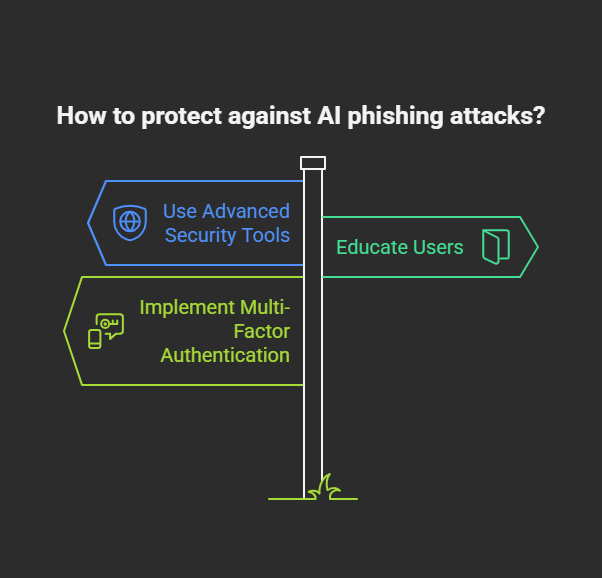AI Phishing Attacks: How to Outsmart the Bots and avoid it

Table of Contents
ToggleIntroduction
“Wait, Did I Really Send That Email?”
Picture this: You get a text from your boss asking you to wire $10,000 to a new vendor urgently. The message sounds exactly like them—same slang, same typos, same GIF of a dancing potato. But here’s the twist: it’s not your boss. It’s an AI-powered phishing scam.
AI isn’t just writing essays and making art anymore. Cybercriminals are using it to craft hyper-personalized, scarily convincing scams. Let’s break down how these attacks work and—more importantly—how you can fight back.
1.Old Phishing vs. New AI Phishing: What’s the Difference?
Traditional Phishing
– Generic emails (“Dear Customer, your account is locked!”).
– Poor grammar, obvious fake links (e.g., “www.paypa1-security.com”).
AI Supercharged Phishing
– Personalized: Scammers use AI to scrape your social media, job title, or even your writing style to mimic you.
– Deepfakes: Voice clones of your CEO asking for money, or fake video calls.
– Scale: AI generates thousands of unique emails in seconds, bypassing old spam filters.
Fact: In 2023, a finance worker in Hong Kong transferred $25 million to fraudsters after a deepfake video call with his CFO.
2.“How Do I Spot an AI Phishing Attack?” (Spoiler: It’s Getting Harder)
AI scams are sneaky, but here are red flags:
– Too. Much. Detail: An email mentioning your recent vacation, your dog’s name, and your favorite taco spot? Suspicious.
– Urgency Overload: “Transfer funds NOW or the company collapses!” AI loves pressing your panic button.
– Perfect Imperfections: Some AI tools still slip up (e.g., odd phrasing, mismatched logos).
Interactive Check: Which of these is a phishing email?
- A) “Hi Mr. A , your package delivery failed. Click here to reschedule.”
- B) “Hey Sam, loved your LinkedIn post on cybersecurity! BTW, need you to confirm your payroll details ASAP. -Jen”
(Answer: Both could be scams, but B uses flattery + urgency—a classic AI move!)

3.Mitigation Strategies: How to Fight AI with AI (and Common Sense)
Strategy 1: Train Humans First
Teach “Slow Down” Mode: Urgency = danger. Train teams to verify requests via a second channel (e.g., call the CEO’s real number).
-Run Simulated Attacks: Use tools like KnowBe4 to send fake AI phishing emails and see who clicks.
Strategy 2: Deploy AI Defenders
Upgrade Email Filters: Use AI-powered tools like Microsoft Defender or Mimecast to detect subtle phishing patterns.
DMARC/DKIM/SPF: Technical jargon for “validate sender emails so scammers can’t spoof ‘@yourcompany.com’.”
Strategy 3: Kill the Password
– Enforce MFA Everywhere: Even if a hacker gets your password, they can’t bypass multi-factor authentication (e.g., a fingerprint + code).
– Go Passwordless: Use biometrics or hardware keys (e.g., Yubikey) where possible.
Strategy 4: Limit Data Leaks
– Lock Down Social Media: Restrict LinkedIn/work details. That “birthday post” for your coworker? Scraped by AI.
– Use a Burner Email: For sign-ups, use a secondary email to protect your main account.
4.“But What If I’m Already Hacked?” Damage Control 101
- Disconnect: Unplug from the internet to stop data leaks.
- Change Passwords: Prioritize email, banking, and work accounts.
- Report It: Notify your IT team, bank, or platforms like reportphishing@apwg.org.
5.The Future: Will AI Save Us or Ruin Us?
AI is a double-edged sword. While criminals abuse it, tools like ChatGPT-4 can also:
– Analyze emails for phishing red flags.
– Generate secure passwords.
– Simulate attacks to train employees.
Your Homework


Final Thought: AI phishing is like a never-ending game of whack-a-mole. But with the right mix of skepticism, tech, and training, you’ll stay ahead of the bots.
Over to You: Have you seen an AI phishing attempt? Share your story in the comments—let’s crowdsource survival tips!
TL;DR: AI makes phishing scarily personal. Fight back with multi-factor auth, AI filters, and a healthy dose of “Wait, let me call you to confirm.”
Like this? Hit subscribe for a free cheat sheet: “10 Phrases Scammers Say (and How to Reply)”!